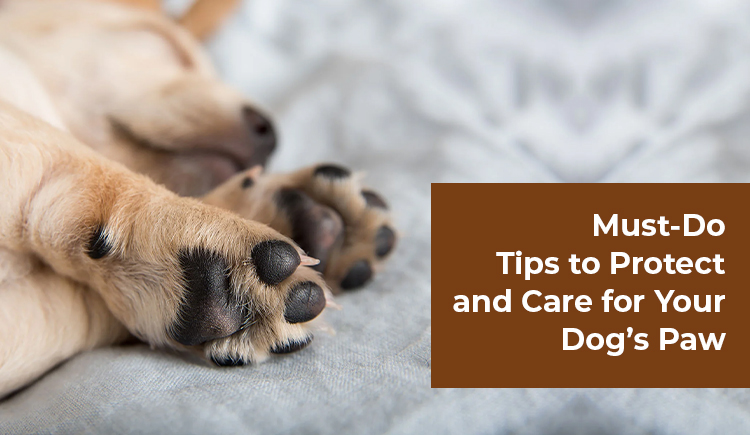
Dog paws have sensitive skin and require special care and protection. Dog paws walk different surfaces and rough terrains, and therefore, problems like cuts and abrasions, cracked paw pads, allergies, infections, cysts, or nail issues may occur. Changing weather can also impact your dog’s paws.
This blog details dog paw problems, common paw injuries, and tips to protect and care for your dog’s paw. Let’s begin with the signs that indicate your dog’s paw has an issue.
Signs of Paw Pad Issues and Injuries in Dogs
Always check your dog’s paws for the following signs:
- Licking or chewing affected paws
- Cuts, abrasions, and tears
- Dry and cracked pads
- Cracked and torn nails
- Red and inflamed paws
- Wounds and discharge
- Hair loss around paws
- Ulcers with scabbing and blisters
- Cysts and growths
- Loose skin flaps on paw pads
- Bleeding
- Lameness or limping
- Refusal to walk or bear weight on paws
- A foul smell coming from the paw
If you notice any of the above signs of paw problems, dig in deeper to know the cause. If the symptoms are severe, fix an appointment with your veterinarian straight away.
Causes of Paw Pad Issues and Injuries in Dogs
Paw pads are insulators for a dog’s feet and provide grip along with assisting with balance, slowing down, and stopping. Damage to the paw can affect the mobility of your dog. Some of the causes of paw pad injuries and issues are listed below:
Allergies
Dogs can suffer from various types of allergies which cause itchiness in the paw. Your dog may lick, bite, or chew on its paws to relieve the itching and irritation. This may lead to further injuries and make the paws more vulnerable to secondary bacterial and fungal infections.
Fungal and Bacterial Infections
Bacterial and fungal infections are common in dogs, and paws are more susceptible to developing these infections as they come in direct contact with various surfaces. The outburst of fungi and bacteria that live on your dog’s paw can cause infection.
Signs that your canine’s paw is infected with an infection are redness, swelling, itching, pain, and greasy discharge. Usually, the skin between the folds of the toes is prone to bacterial and fungal infection. Many a time brown discoloration of nails also indicates an infection.
Nail Issues
Long toenails are common in dogs and may harm your dog. These nails pose difficulty walking as the hard surface pushes them back into the nail bed, causing pain. This even pressurizes all the toe joints, and your dog may suffer from a fractured or torn nail that may cause bleeding.
When nails are not trimmed properly, they naturally wear out during walking and become irritating ingrown toenails.
Burns and Blisters
Walking your dog on hot surfaces, especially during summer, may burn your dog’s soft paw skin, causing swelling, redness, or blisters. Paw burns make it difficult for your dog to move around and need immediate medical attention.
Dry and Cracked Paw Pads
Numerous factors cause dry and cracked paw pads including hot walkways, contact with rough surfaces, winter conditions, dry air, chemicals, and excessive licking. Dry and cracked paws are painful and pose a risk of infection.
Cuts and Abrasions
Dogs run and play on uneven grounds and rough terrains, and small rocks, sticks, broken glass, sharp objects, debris, and burrs on the pavement can cause cuts, abrasions, and lacerations on the paw pads.
Parasites
Parasites like ticks and mites cause infestation between a dog’s toes and are characterized by scaling, hair loss, and swelling. Your veterinarian will test to diagnose and treat these pests.
Cysts and Growths
Lumps, cysts, and growths appear on the dog’s paw or in between its toes. These are painful and must be treated or removed if necessary.
Dog Paw Care and Prevention
Give Your Dog Pedicures
Nail trimming should be done regularly to avoid nails touching the ground and causing trouble. You can also file its nails periodically to keep them short and blunt.
Many safe resources and clippers are available to make the trimming process comfortable and stress-free for your dog.
Consider Weather Conditions
In summer, avoid walking on hot surfaces, pavements, and sand. During winters, do not walk your dog on rock salt or chemical ice melts as these may injure the paw pads, and there is the possibility of ingestion when your dog licks the paw.
To avoid any damage to paws, wash them with warm water after walks and use a moisturizer like Dermoscent Bio Balm for Dogs to prevent dry and cracked paw pads. It is recommended to use lotions specifically formulated for a dog’s paw after consulting your vet.
Also, Read About- 7 Modes of Worm Transmission into Your Dog
Do Paw Checks
Check your dog’s paw after every outdoor activity because during these times are likely your dog can get hurt. Sometimes, any object can get stuck between its toes or pads. Clean any debris and inspect if there are any injuries, blisters, or cuts.
Apply First Aid
In case of minor injuries and bleeding, always use first-aid such as bandage. In case of minor cuts or burns, you can also use dog boots to prevent further damage to the paw pads.
Consult your dog’s veterinarian as he can best diagnose and advise on treatments for paw protection. Your vet will most likely suggest topical creams, moisturizers, and washes to treat paw pads.
Conclusion
Your dog’s paw pads are shock absorbers for its feet bones and joints. Dog paw pads are durable and designed to withstand several activities and the wear and tear caused by daily activities. It is necessary to do paw checks regularly to identify any issues and cure them before the problem worsens. As a pet parent, you must take appropriate steps to keep them healthy and protected.

